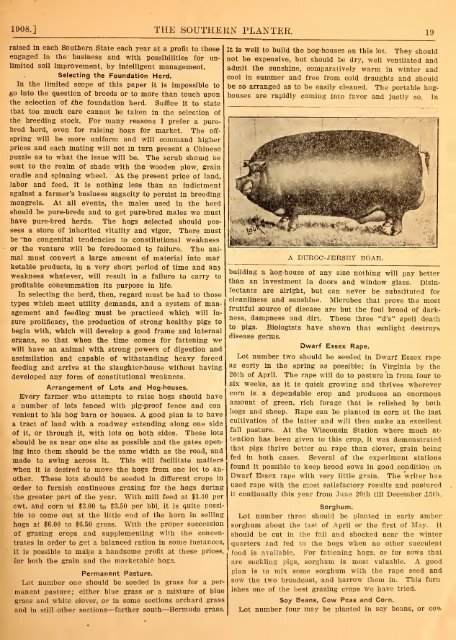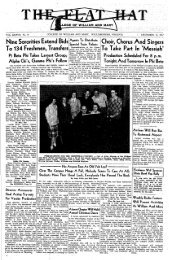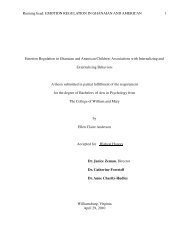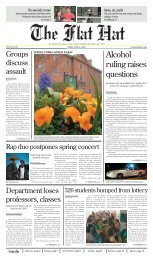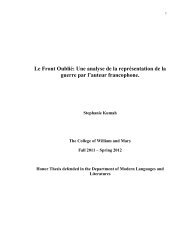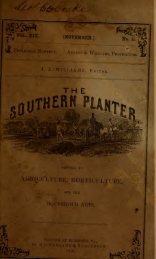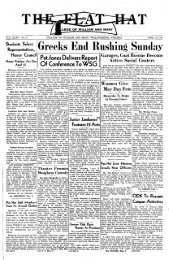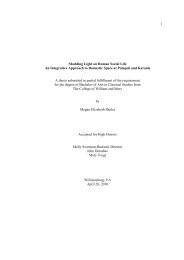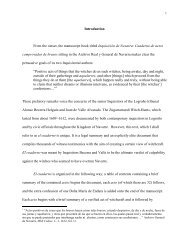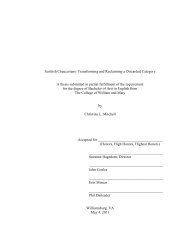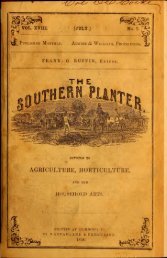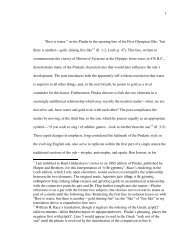Southern planter - The W&M Digital Archive
Southern planter - The W&M Digital Archive
Southern planter - The W&M Digital Archive
Create successful ePaper yourself
Turn your PDF publications into a flip-book with our unique Google optimized e-Paper software.
1908.] THE SOUTHERN PLANTER. 19<br />
raised in each <strong>Southern</strong> State each year at a profit to those<br />
engaged in the business and with possibilities for unlimited<br />
soil improvement, by intelligent management.<br />
Selecting the Foundation Herd.<br />
In the limited scope of this paper it is impossible to<br />
go into the question of breeds or to more than touch upon<br />
the selection of ithe foundation herd. Suffice it to state<br />
that too much care cannot be taken in the selection of<br />
the breeding stock. For many reasons I prefer a pure-<br />
bred herd, even for raising hogs for market. <strong>The</strong> off-<br />
spring will be more uniform and will command higher<br />
prices and each mating will not in turn present a Chinese<br />
puzzle as to what the issue will be. <strong>The</strong> scrub should be<br />
sent to the realm of shade with the wooden plow, grain<br />
cradle and spinning wheel. At the present price of land,<br />
labor and feed, it is nothing less than an indictment<br />
against a farmer's business sagacity to persist in breeding<br />
mongrels. At all events, the males used in the herd<br />
should be pure-breds and to get pure-bred males we must<br />
have pure-bred herds. <strong>The</strong> hogs selected should possess<br />
a store of inherited vitality and vigor. <strong>The</strong>re must<br />
be ~no congenital tendencies to constitutional weakness<br />
or the venture will be foredoomed to failure. <strong>The</strong> animal<br />
must convert a large amount of material into mar<br />
ketable products, in a very short period of time and anj<br />
weakness whatever, will result in a failure to carry to<br />
profitable consummation its purpose in life.<br />
In selecting the herd, then, regard must be had to those<br />
types which meet utility demands, and a system of management<br />
and feeding must be practiced which will in-<br />
sure prolificacy, the production of strong healthy pigs to<br />
begin with, which will develop a good frame and internal<br />
organs, so that when the time comes for fattening we<br />
will have an animal with strong powers of digestion and<br />
assimilation and capable of withstanding heavy forced<br />
feeding and arrive at the slaughter-house without having<br />
developed any form of constitutional weakness.<br />
Arrangement of Lots and Hog-houses.<br />
Every farmer who attempts to raise hogs should have<br />
a number of lots fenced with pig-proof fence and con<br />
venient to his hog barn or houses. A good plan is to have<br />
a tract of land with a roadway extending along one side<br />
of it, or through it, with lots on both sides. <strong>The</strong>se lots<br />
should be as near one size as possible and the gates opening<br />
into them should be the same width as the road, and<br />
made to swing across it. This will facilitate matters<br />
when it is desired to move the hogs from one lot to an-<br />
other. <strong>The</strong>se lots should be seeded in different crops in<br />
order to furnish continuous grazing for the hogs during<br />
the greater part of the year. With mill feed at $1.40 per<br />
cwt. and corn at $3.00 to $3.50 per bbl. it is quite possi-<br />
ble to come out at the little end of the horn in selling<br />
hogs at $6.00 to $6.50 gross. With the proper succession<br />
of grazing crops and supplementing with the concen-<br />
trates in order to get a balanced ration in some instances,<br />
it is possible to make a handsome profit at these prices,<br />
for both the grain and the marketable hogs.<br />
Permanent Pasture.<br />
Lot number one should be seeded in grass for a permanent<br />
pasture; either blue grass or a mixture of blue<br />
grass and white clover, or in some sections orchard grass<br />
and in still other sections—farther south—Bermuda grass.<br />
It is well to build the hog-houses on this lot. <strong>The</strong>y should<br />
not be expensive, but should be dry, well ventilated and<br />
admit the sunshine, comparatively warm in winter and<br />
cool in summer and free from cold draughts and should<br />
be so arranged as to be easily cleaned. <strong>The</strong> portable hoghouses<br />
are rapidly coming into favor and justly so. In<br />
A DUROC-JERSEY BOAR.<br />
building a hog-house of any size nothing will pay better<br />
than an investment in doors and window glass. Disin-<br />
fectants are alright, but can never be substituted for<br />
cleanliness and sunshine. Microbes that prove the most<br />
fruitful source of disease are but the foul brood of darkness,<br />
dampness and dirt. <strong>The</strong>se three "d's" spell death<br />
to pigs. Biologists have shown that sunlight destroys<br />
disease germs.<br />
Dwarf Essex Rape.<br />
Lot number two should be seeded in Dwarf Essex rape<br />
as early in the spring as possible; in Virginia by the<br />
20th of April. <strong>The</strong> rape will do to pasture in from four to<br />
six weeks, as it is quick growing and thrives wherever<br />
corn is a dependable crop and produces an enormous<br />
amount of green, rich forage that is relished by both<br />
hogs and sheep. Rape can be planted in corn at the last<br />
cultivation of the latter and will then make an excellent<br />
fall pasture. At the Wisconsin Station where much attention<br />
has been given to this crop, it was demonstrated<br />
that pigs thrive better on rape than clover, grain being<br />
fed in both cases. Several of the experiment stations<br />
found it possible to keep brood sows in good condition on<br />
Dwarf Essex rape with very little grain. <strong>The</strong> writer has<br />
used rape with the most satisfactory results and pastured<br />
it continually this year from June 20th till December ,15th.<br />
Sorghum.<br />
Lot number three should be planted in early amber<br />
sorghum about the last of April or the first of May. It<br />
should be cut in the fall and shocked near the winter<br />
quarters and fed to the hogs when no other succulent<br />
food is available, For fattening hogs, or for sows that<br />
are suckling pigs, sorghum is most valuable. A good<br />
plan is to mix some sorghum with the rape seed and<br />
sow the two broadcast, and harrow them in. This furn<br />
ishes one of the best grazing crops we have tried.<br />
Soy Beans, Cow Peas and Corn.<br />
Lot number four may be planted in soy beans, or cow


